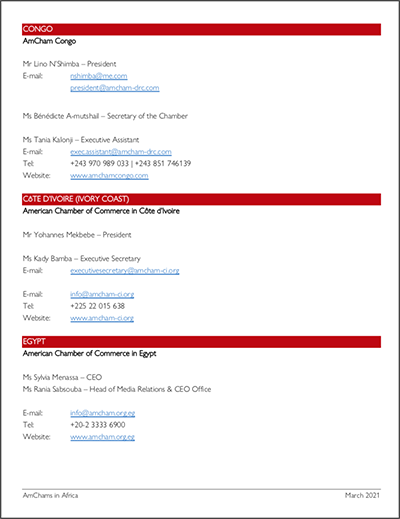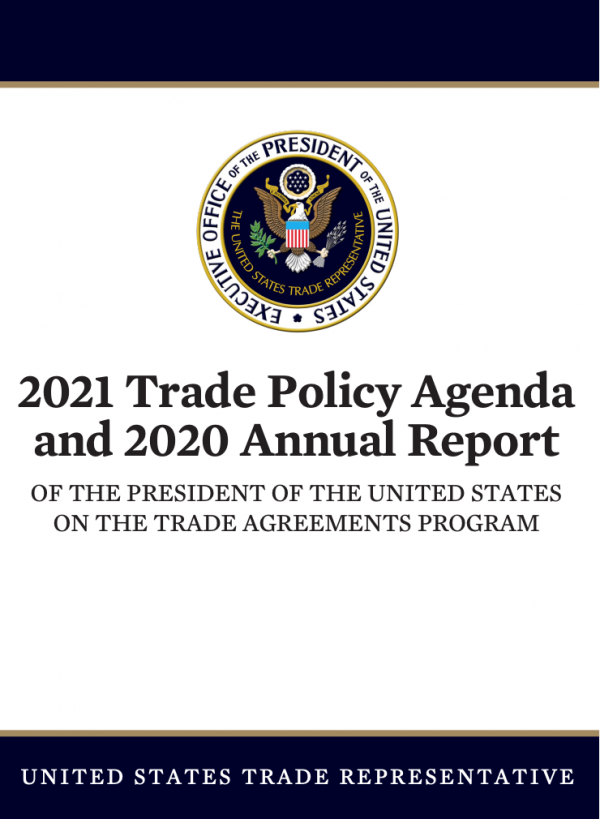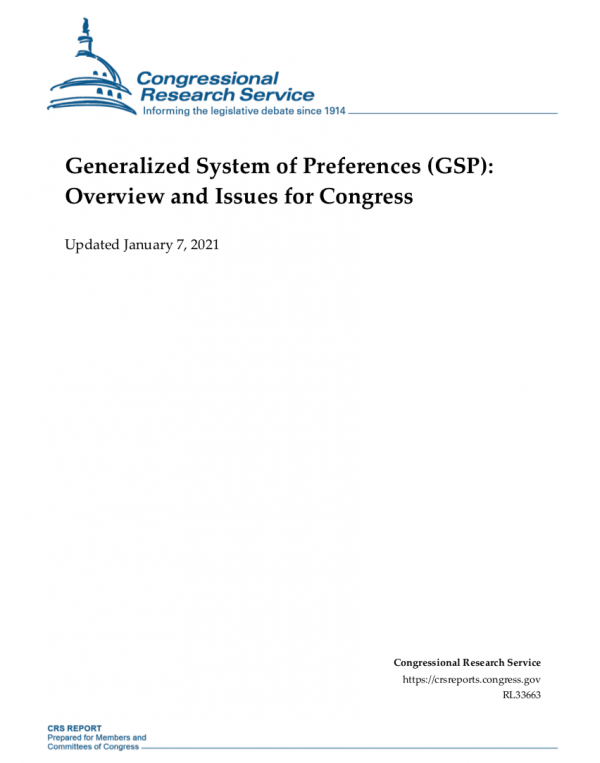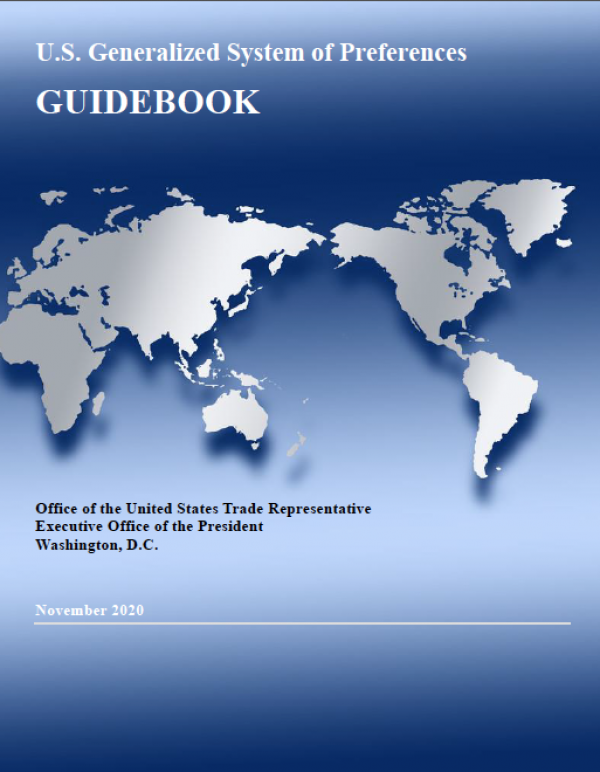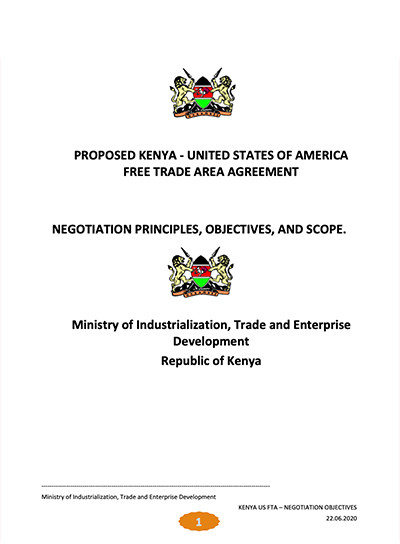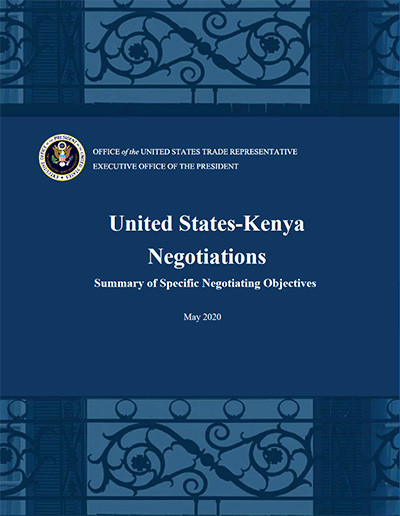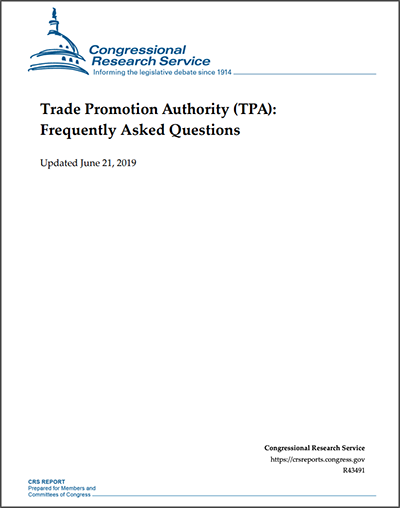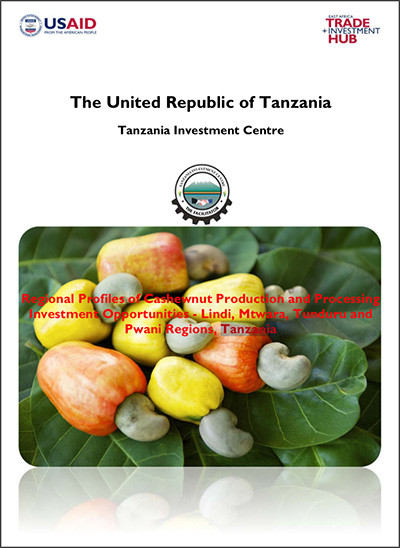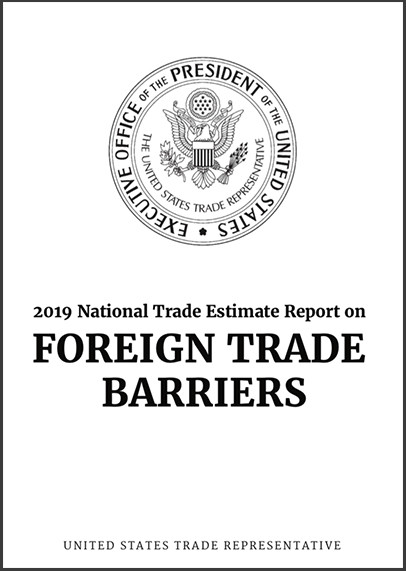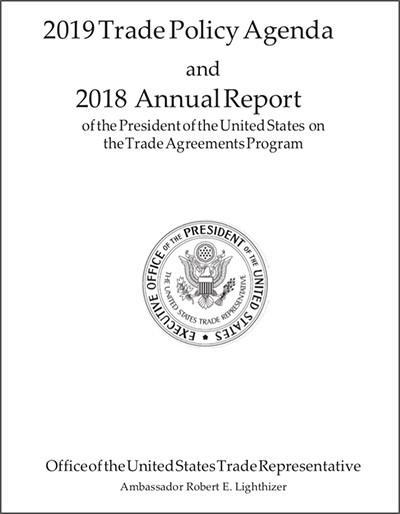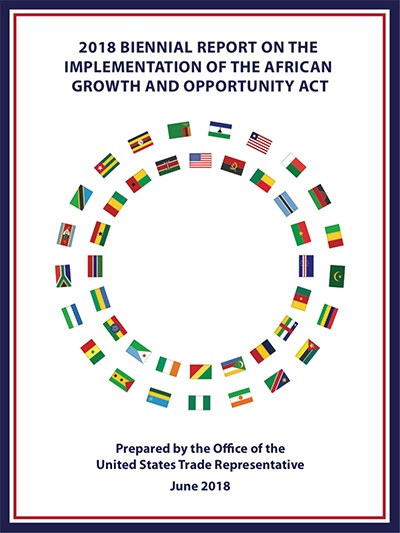General Documents
American Chambers in Africa - Contact Details
2021 Trade Policy Agenda and 2020 Annual Report
The 2021 Trade Policy Agenda and 2020 Annual Report of the President of the United States on the Trade Agreements Program are submitted to the Congress pursuant to Section 163 of the Trade Act of 1974, as amended (19 U.S.C. § 2213). Chapter IV and Annex III of this document meet the requirements of Sections 122 and 124 of the Uruguay Round Agreements Act with respect to the World Trade Organization. The discussion on the Generalized System of Preferences in Chapter II satisfies the reporting requirement contained in the Consolidated Appropriations Act, 2018 (Pub. L. 115-141, div. M, title V, § 501(c)). This report includes an annex listing trade agreements entered into by the United States since 1984. Goods trade data are for full year 2020. Full-year services data by country are only available through 2019.
Generalized System of Preferences (GSP): Overview and issues for Congress
The U.S. Generalized System of Preferences (GSP) program provides nonreciprocal, duty-free tariff treatment to certain products imported to the United States from designated beneficiary developing countries (BDCs). Congress first authorized the U.S. program in Title V of the Trade Act of 1974. The European Union and other developed countries have implemented similar programs since the 1970s. Most recently, Congress extended the U.S. GSP program in Division M, Title V of the Consolidated Appropriations Act, 2018 (P.L. 115-141). This act extended the GSP program until December 31, 2020, as well as retroactively renewing it for the time period between December 31, 2017 (the previous expiration date) and April 22, 2018. The program expired on December 31, 2020, before Congress passed legislation to reauthorize it. This report examines, first, recent legislative developments, along with a brief history, economic rationale, and legal background leading to the establishment of GSP. Second, the report describes U.S. GSP implementation. Third, the report briefly analyzes the U.S. program’s effectiveness and stakeholders’ views, and discusses possible options for Congress.
United States GSP Guidebook 2020
The U.S. Generalized System of Preferences (GSP), a program designed to promote economic growth in the developing world, provides preferential duty-free treatment for approximately 3,500 products from a wide range of designated beneficiary developing countries (BDCs), including many least-developed beneficiary developing countries (LDBDCs). An additional approximately 1,500 products are GSP-eligible only when imported from LDBDCs. The GSP program, first authorized by the Trade Act of 1974, came into effect on January 1, 1976. Authorization of the GSP program expired on December 31, 2017. On March 23, 2018, the President signed legislation authorizing the GSP program through December 31, 2020, retroactive to January 1, 2018. The purpose of this Guidebook is to facilitate public understanding of the GSP program and the documents that implement the program. Much of the information contained in this guide overlaps with AGOA requirements.
Kenya private sector consortium comments on the FTA objectives
These comments are submitted in response to the open invitation by the Cabinet Secretary, Ministry of Industrialisation, Trade and Enterprise Development to submit comments to enrich the Kenya-U.S. Free Trade Agreement (FTA) Negotiations. The Private Sector Consortium is a working group setup purely to provide private sector input to the FTA. The Consortium comprises of representatives from the American Chamber of Commerce Kenya, the Kenya Private Sector Alliance, the Kenya National Chamber of Commerce and Industry, the Kenya Association of Manufacturers and select industry experts. As private sector we view the FTA as an opportunity to drive mutual economic growth through predictable, increased trade and investment, creation of quality jobs, increased innovation, and enhanced productivity. We thus welcome this opportunity to submit our comments.
Kenya's US FTA negotiating principles - June 2020
Kenya and the US, in February 2020 jointly announced their intent to initiate negotiations on a Free Trade Agreement (FTA) between themselves. Towards this end, the Ministry of Industrialization, Trade and Enterprise Development having consulted and heard from from various stakeholders developed Negotiating Objectives and Principles to guide the negotiations for this first bilateral FTA between Kenya and the US. This is now made available for public review. The Ministry looks forward to receiving comments to enrich our preparations for the Negotiations. Ms. Betty Maina CBS Cabinet Secretary Ministry of Industrialisation, Trade and Enterprise Development.
US FTA negotiating principles (Kenya FTA) - May 2020
On March 17, 2020, the Trump Administration notified Congress that the President intends to negotiate a trade agreement with the Republic of Kenya, in accordance with section 105(a)(1)(A) of the Bipartisan Congressional Trade Priorities and Accountability Act of 2015 (the Trade Priorities and Accountability Act). This notification was made following a February 6, 2020, meeting at the White House between President Trump and Kenyan President Uhuru Kenyatta where the two presidents agreed to pursue negotiations on a trade agreement between the United States and Kenya. In pursuing negotiations on a trade agreement with Kenya, we are responding to Congress’ support, as expressed in the African Growth and Opportunity Act (AGOA), to negotiate reciprocal and mutually beneficial trade agreements that serve the interests of both the United States and the countries of sub-Saharan Africa. Our vision is to conclude an agreement with Kenya that can serve as a model for additional agreements in Africa, leading to a network of agreements that contribute to Africa’s regional integration objectives. In addition, our goal is to conclude an agreement that builds on the objectives of AGOA and will serve as an enduring foundation to expand U.S.-Africa trade and investment across the continent. We seek to support higher-paying jobs in the United States and grow the U.S. economy by improving U.S. opportunities for trade and investment with Kenya. The current health crisis and economic...
US Trade and investment with Sub-Saharan Africa: Recent developments 2020 Report
This report provides information on U.S. trade and investment with sub-Saharan Africa (SSA). In particular, it analyzes the sectors in which U.S. trade in goods and services with SSA showed the strongest growth during 2016–18; identifies SSA countries for which U.S. exports, imports, and outward foreign direct investment (FDI) increased the most during the period; and highlights the main factors behind this growth. Focusing on several SSA countries, including South Africa, Nigeria, Kenya, Ghana, Rwanda, Ethiopia, and Côte d’Ivoire (called “key markets” in this report), the Commission used case studies to provide in-depth analysis of trends in four important areas: (1) the ways U.S. products and services integrate into key SSA value chains; (2) the intellectual property environment in the key SSA markets, and the effects of that environment on trade and investment; (3) technological innovations in SSA agricultural production and exports; and (4) the digital economy in SSA. In examining SSA’s digital economy, the report explores how the adoption of digital technologies affects other industries and how policies and market conditions affect digital trade. Further, this report summarizes recent developments in regional integration efforts in SSA, particularly the negotiation and implementation of the African Continental Free Trade Area. It also includes a summary of SSA countries’ utilization of preferential trade provisions under the African Growth and...
Trade Promotion Authority - Frequently Asked Questions
Legislation to reauthorize Trade Promotion Authority (TPA)—sometimes called “fast track”— the Bipartisan Congressional Trade Priorities and Accountability Act of 2015 (TPA-2015), was signed into law by former President Obama on June 29, 2015 (P.L. 114-26). If the President negotiates an international trade agreement that would reduce tariff or nontariff barriers to trade in ways that require changes in U.S. law, the United States can implement the agreement only through the enactment of legislation. If the trade agreement and the process of negotiating it meet certain requirements, TPA allows Congress to consider the required implementing bill under expedited procedures, pursuant to which the bill may come to the floor without action by the leadership, and can receive a guaranteed up-or-down vote with no amendments.
Tanzania: Regional profiles of cashew nut production and processing investment opportunities
Cashew nuts are grown in the Southern parts of Tanzania, on the opposite side of the border of the cashew-growing region of Mozambique. Cashew nuts originate from Brazil; Portuguese traders brought the seeds to Africa in the 16th century. The trees soon found their way to Mtwara region; an Indian Ocean port on trade routes once plied by David Livingstone. Tanzania is now the World’s 3rd largest producer of cashews and maybe the world’s most important, with production growing 450% (data collected from 2004 – 2018)...
2019 US National trade estimate report on foreign trade barriers
The 2019 National Trade Estimate Report on Foreign Trade Barriers (NTE) is the 34th in an annual series that highlights significant foreign barriers to U.S. exports, U.S. foreign direct investment, and U.S. electronic commerce. This document is a companion piece to the President’s 2019 Trade Policy Agenda and 2018 Annual Report, published by Office of the United States Trade Representative (USTR) in March.
2019 US Trade Policy Agenda and 2018 Annual Report
On March 1, 2019, the United States Trade Representative released President Trump’s 2019 Trade Policy Agenda and Annual Report, outlining how the Administration’s trade policies are benefitting American workers, contributing to the strongest U.S. economy in decades, and rebalancing America’s trade relationships and the global economy.
2018 AGOA Implementation Report
Section 110 of the Trade Preferences Extension Act of 2015 (“the Act”), 19 U.S.C. § 3705 note, states that the President1 shall submit a report to Congress on the trade and investment relationship between the United States and sub-Saharan African countries no later than one year after the enactment of the Act, and biennially thereafter. The U.S. Trade Representative, on behalf of the President, submitted the first report under this provision in June 2016. The current report covers the period since then. It provides a description of the status of trade and investment between the United States and sub-Saharan Africa, changes in country eligibility for AGOA benefits, an analysis of country compliance with the AGOA eligibility criteria, an overview of regional integration efforts in sub-Saharan Africa, and a summary of U.S. trade capacity building efforts.
AGOA 101 Kenya - Exporter Guide 2018
The USAID East Africa Trade and Investment Hub helps East African businesses take advantage of the African Growth and Opportunity Act (AGOA). AGOA allows for duty-free export of over 6,000 products. This guide outlines the step-by-step process that Kenyan businesses should take to export to the United States of America (U.S.A.) duty-free through AGOA and gives a general overview for the export of all AGOA products from Kenya. It provides additional information on the export of four high-demand, high-value sectors, namely textiles and apparel; coffee; nuts and oil crops; and cut flowers. Although exporting can be a challenging process, it can also be profitable for the individual or company that successfully complies with the steps. Exporters must follow two sets of requirements: Kenyan laws and regulations that govern the export process, and Laws and regulations that govern the destination country’s imports, in this case, the U.S.A. Regulations also vary according to the product being exported; exporters must research to ensure that their product meets the necessary requirements for export. This guide assumes that the exporter or potential exporter has already conducted the necessary market research, and is ready to export. Before proceeding, exporters must identify the correct tariff code and its eligibility for dutyfree export under AGOA. This status can be established by referring to...


